Management Communication: Establishing Effective Channels
VerifiedAdded on 2023/06/04
|10
|2350
|110
Essay
AI Summary
This essay provides a comprehensive overview of organizational communication, differentiating between formal and informal channels. It delves into the intricacies of formal communication, highlighting downward, upward, and horizontal communication strategies. The role of management in fostering effective internal communications is emphasized, including setting goals, providing job instructions, offering performance feedback, and facilitating coaching and training. The essay further explores how upward communication enables employees to voice concerns and provide suggestions, while horizontal communication promotes interdepartmental coordination and problem-solving. Ultimately, the essay underscores the importance of establishing and maintaining these communication channels for organizational success, concluding that the flow of communication depends on the type of channel adopted.
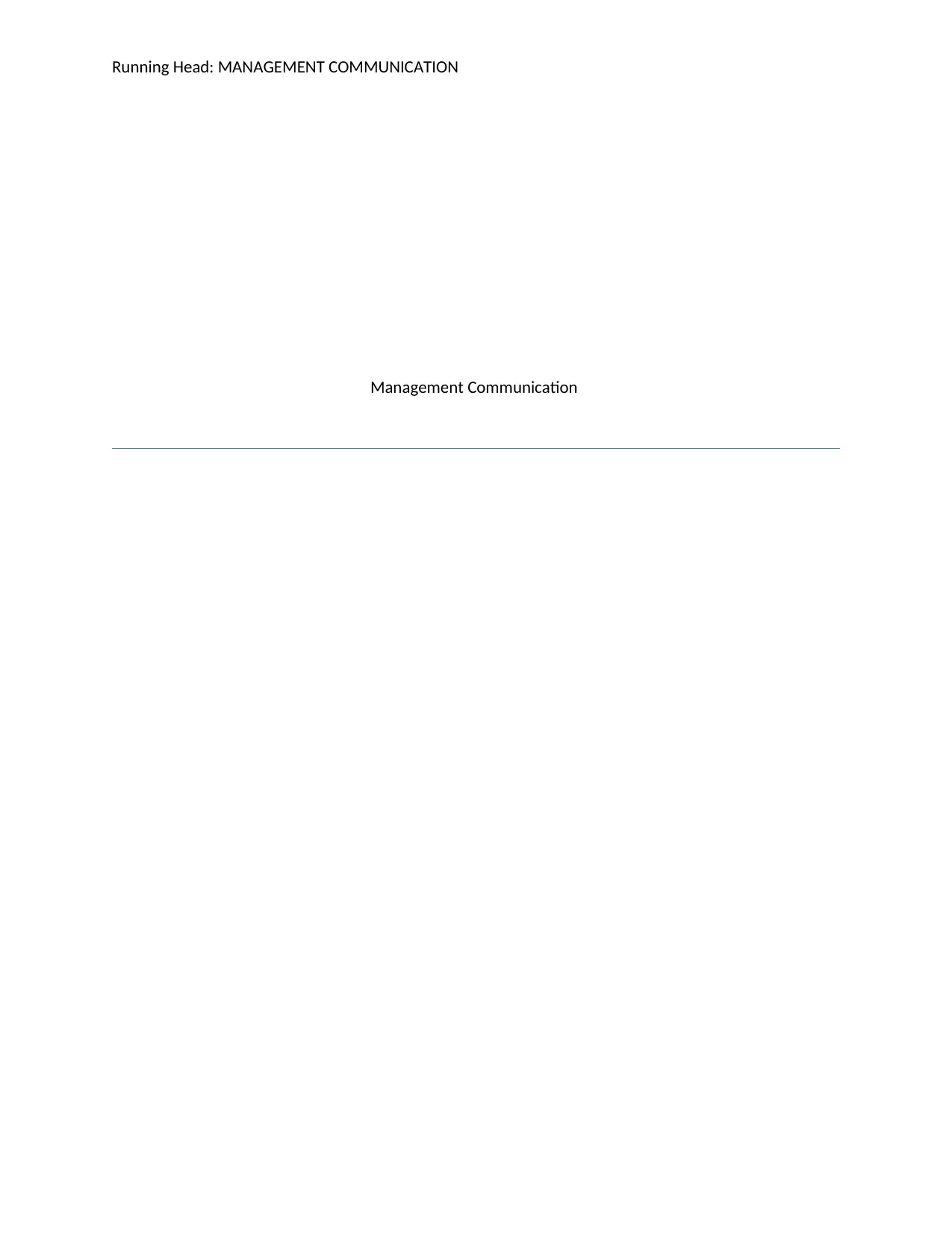
Running Head: MANAGEMENT COMMUNICATION
Management Communication
Management Communication
Paraphrase This Document
Need a fresh take? Get an instant paraphrase of this document with our AI Paraphraser
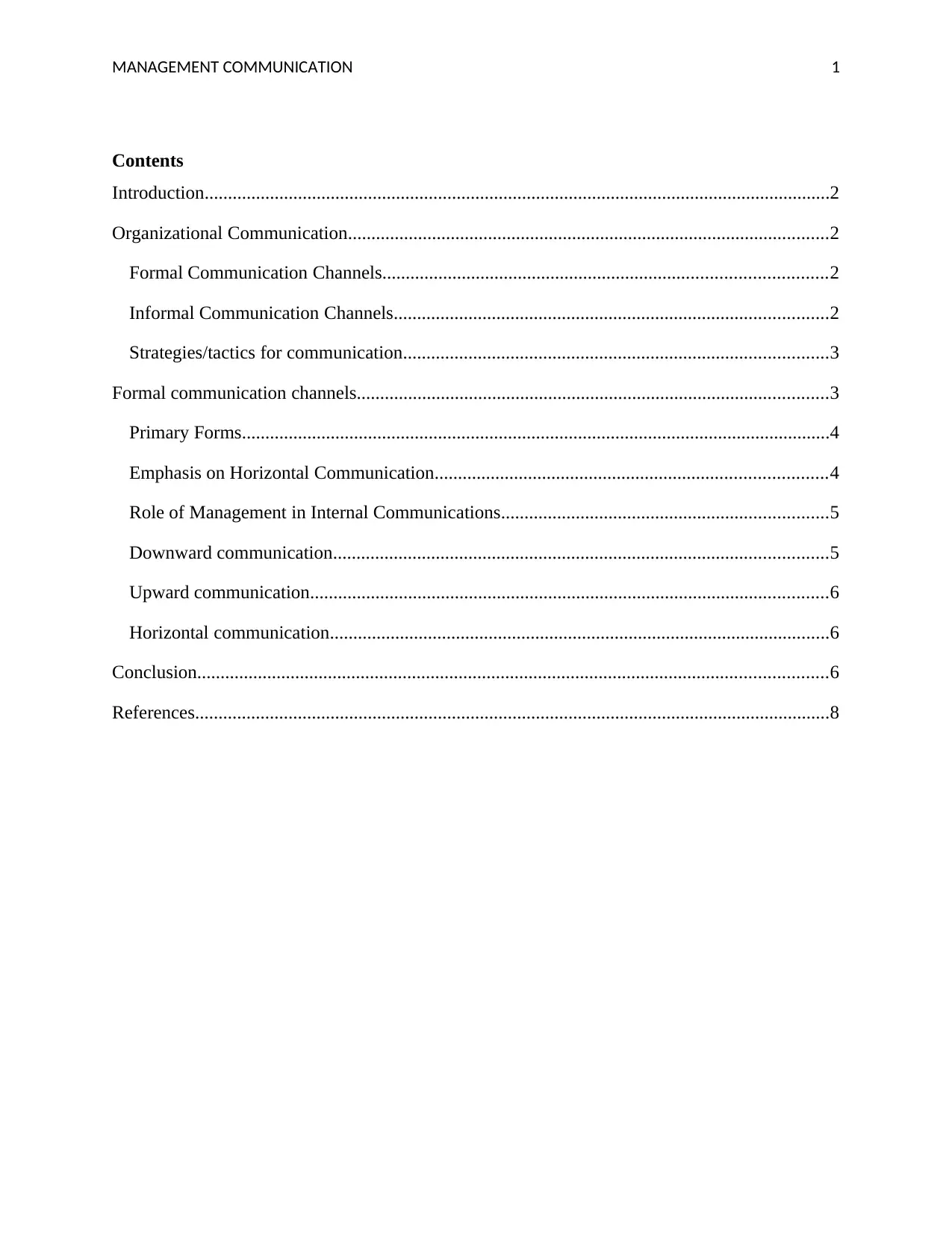
MANAGEMENT COMMUNICATION 1
Contents
Introduction......................................................................................................................................2
Organizational Communication.......................................................................................................2
Formal Communication Channels...............................................................................................2
Informal Communication Channels.............................................................................................2
Strategies/tactics for communication...........................................................................................3
Formal communication channels.....................................................................................................3
Primary Forms..............................................................................................................................4
Emphasis on Horizontal Communication....................................................................................4
Role of Management in Internal Communications......................................................................5
Downward communication..........................................................................................................5
Upward communication...............................................................................................................6
Horizontal communication...........................................................................................................6
Conclusion.......................................................................................................................................6
References........................................................................................................................................8
Contents
Introduction......................................................................................................................................2
Organizational Communication.......................................................................................................2
Formal Communication Channels...............................................................................................2
Informal Communication Channels.............................................................................................2
Strategies/tactics for communication...........................................................................................3
Formal communication channels.....................................................................................................3
Primary Forms..............................................................................................................................4
Emphasis on Horizontal Communication....................................................................................4
Role of Management in Internal Communications......................................................................5
Downward communication..........................................................................................................5
Upward communication...............................................................................................................6
Horizontal communication...........................................................................................................6
Conclusion.......................................................................................................................................6
References........................................................................................................................................8
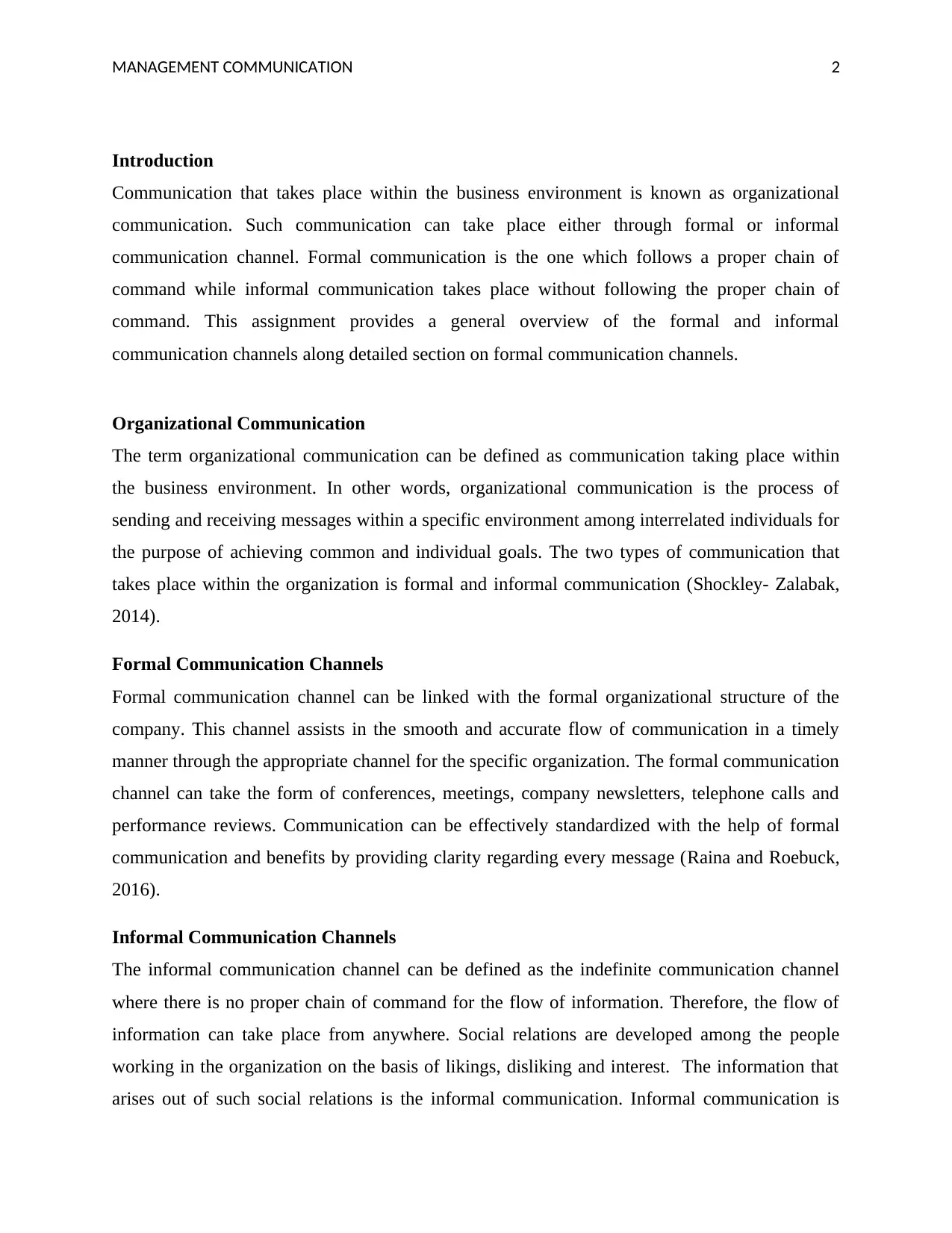
MANAGEMENT COMMUNICATION 2
Introduction
Communication that takes place within the business environment is known as organizational
communication. Such communication can take place either through formal or informal
communication channel. Formal communication is the one which follows a proper chain of
command while informal communication takes place without following the proper chain of
command. This assignment provides a general overview of the formal and informal
communication channels along detailed section on formal communication channels.
Organizational Communication
The term organizational communication can be defined as communication taking place within
the business environment. In other words, organizational communication is the process of
sending and receiving messages within a specific environment among interrelated individuals for
the purpose of achieving common and individual goals. The two types of communication that
takes place within the organization is formal and informal communication (Shockley- Zalabak,
2014).
Formal Communication Channels
Formal communication channel can be linked with the formal organizational structure of the
company. This channel assists in the smooth and accurate flow of communication in a timely
manner through the appropriate channel for the specific organization. The formal communication
channel can take the form of conferences, meetings, company newsletters, telephone calls and
performance reviews. Communication can be effectively standardized with the help of formal
communication and benefits by providing clarity regarding every message (Raina and Roebuck,
2016).
Informal Communication Channels
The informal communication channel can be defined as the indefinite communication channel
where there is no proper chain of command for the flow of information. Therefore, the flow of
information can take place from anywhere. Social relations are developed among the people
working in the organization on the basis of likings, disliking and interest. The information that
arises out of such social relations is the informal communication. Informal communication is
Introduction
Communication that takes place within the business environment is known as organizational
communication. Such communication can take place either through formal or informal
communication channel. Formal communication is the one which follows a proper chain of
command while informal communication takes place without following the proper chain of
command. This assignment provides a general overview of the formal and informal
communication channels along detailed section on formal communication channels.
Organizational Communication
The term organizational communication can be defined as communication taking place within
the business environment. In other words, organizational communication is the process of
sending and receiving messages within a specific environment among interrelated individuals for
the purpose of achieving common and individual goals. The two types of communication that
takes place within the organization is formal and informal communication (Shockley- Zalabak,
2014).
Formal Communication Channels
Formal communication channel can be linked with the formal organizational structure of the
company. This channel assists in the smooth and accurate flow of communication in a timely
manner through the appropriate channel for the specific organization. The formal communication
channel can take the form of conferences, meetings, company newsletters, telephone calls and
performance reviews. Communication can be effectively standardized with the help of formal
communication and benefits by providing clarity regarding every message (Raina and Roebuck,
2016).
Informal Communication Channels
The informal communication channel can be defined as the indefinite communication channel
where there is no proper chain of command for the flow of information. Therefore, the flow of
information can take place from anywhere. Social relations are developed among the people
working in the organization on the basis of likings, disliking and interest. The information that
arises out of such social relations is the informal communication. Informal communication is
⊘ This is a preview!⊘
Do you want full access?
Subscribe today to unlock all pages.

Trusted by 1+ million students worldwide
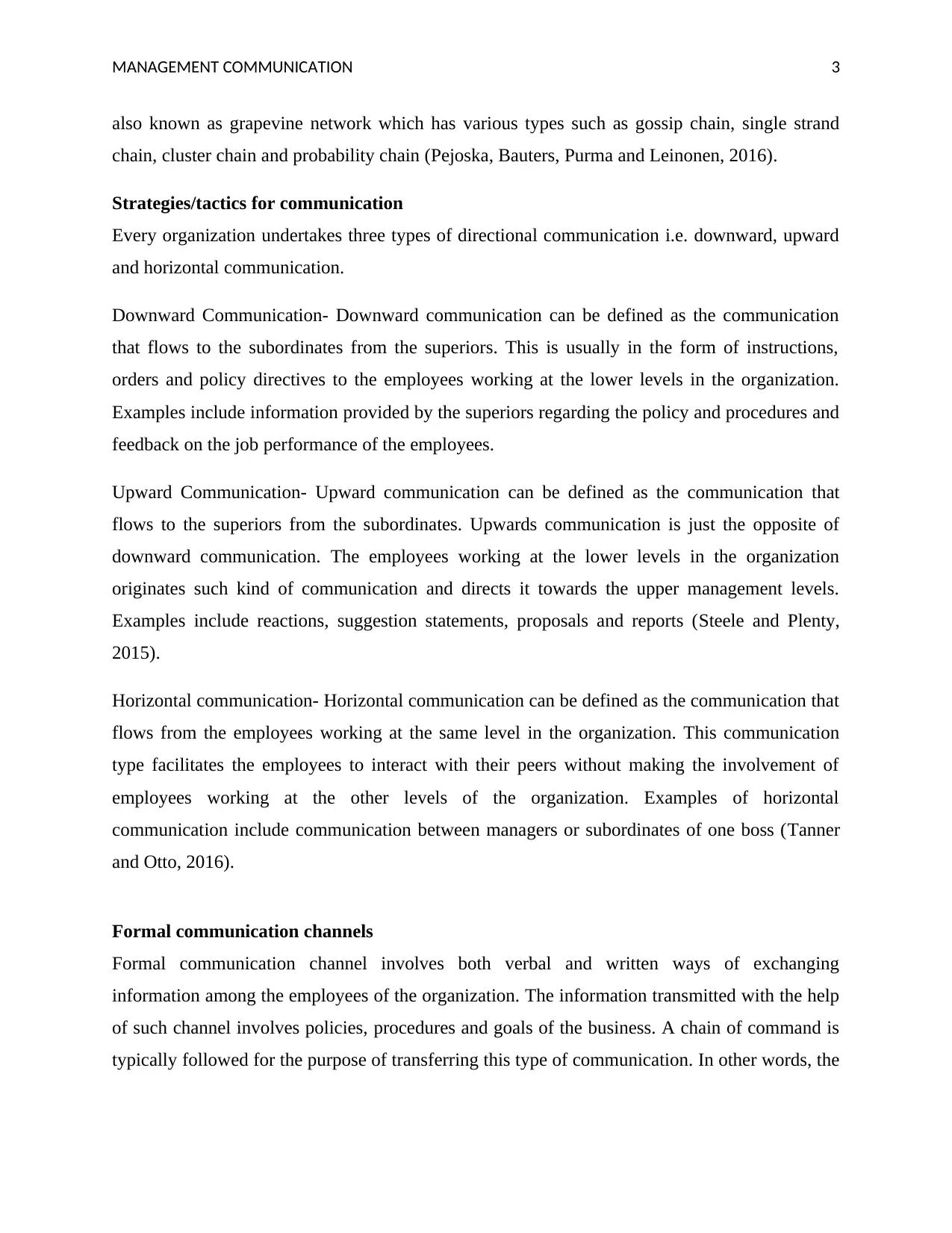
MANAGEMENT COMMUNICATION 3
also known as grapevine network which has various types such as gossip chain, single strand
chain, cluster chain and probability chain (Pejoska, Bauters, Purma and Leinonen, 2016).
Strategies/tactics for communication
Every organization undertakes three types of directional communication i.e. downward, upward
and horizontal communication.
Downward Communication- Downward communication can be defined as the communication
that flows to the subordinates from the superiors. This is usually in the form of instructions,
orders and policy directives to the employees working at the lower levels in the organization.
Examples include information provided by the superiors regarding the policy and procedures and
feedback on the job performance of the employees.
Upward Communication- Upward communication can be defined as the communication that
flows to the superiors from the subordinates. Upwards communication is just the opposite of
downward communication. The employees working at the lower levels in the organization
originates such kind of communication and directs it towards the upper management levels.
Examples include reactions, suggestion statements, proposals and reports (Steele and Plenty,
2015).
Horizontal communication- Horizontal communication can be defined as the communication that
flows from the employees working at the same level in the organization. This communication
type facilitates the employees to interact with their peers without making the involvement of
employees working at the other levels of the organization. Examples of horizontal
communication include communication between managers or subordinates of one boss (Tanner
and Otto, 2016).
Formal communication channels
Formal communication channel involves both verbal and written ways of exchanging
information among the employees of the organization. The information transmitted with the help
of such channel involves policies, procedures and goals of the business. A chain of command is
typically followed for the purpose of transferring this type of communication. In other words, the
also known as grapevine network which has various types such as gossip chain, single strand
chain, cluster chain and probability chain (Pejoska, Bauters, Purma and Leinonen, 2016).
Strategies/tactics for communication
Every organization undertakes three types of directional communication i.e. downward, upward
and horizontal communication.
Downward Communication- Downward communication can be defined as the communication
that flows to the subordinates from the superiors. This is usually in the form of instructions,
orders and policy directives to the employees working at the lower levels in the organization.
Examples include information provided by the superiors regarding the policy and procedures and
feedback on the job performance of the employees.
Upward Communication- Upward communication can be defined as the communication that
flows to the superiors from the subordinates. Upwards communication is just the opposite of
downward communication. The employees working at the lower levels in the organization
originates such kind of communication and directs it towards the upper management levels.
Examples include reactions, suggestion statements, proposals and reports (Steele and Plenty,
2015).
Horizontal communication- Horizontal communication can be defined as the communication that
flows from the employees working at the same level in the organization. This communication
type facilitates the employees to interact with their peers without making the involvement of
employees working at the other levels of the organization. Examples of horizontal
communication include communication between managers or subordinates of one boss (Tanner
and Otto, 2016).
Formal communication channels
Formal communication channel involves both verbal and written ways of exchanging
information among the employees of the organization. The information transmitted with the help
of such channel involves policies, procedures and goals of the business. A chain of command is
typically followed for the purpose of transferring this type of communication. In other words, the
Paraphrase This Document
Need a fresh take? Get an instant paraphrase of this document with our AI Paraphraser
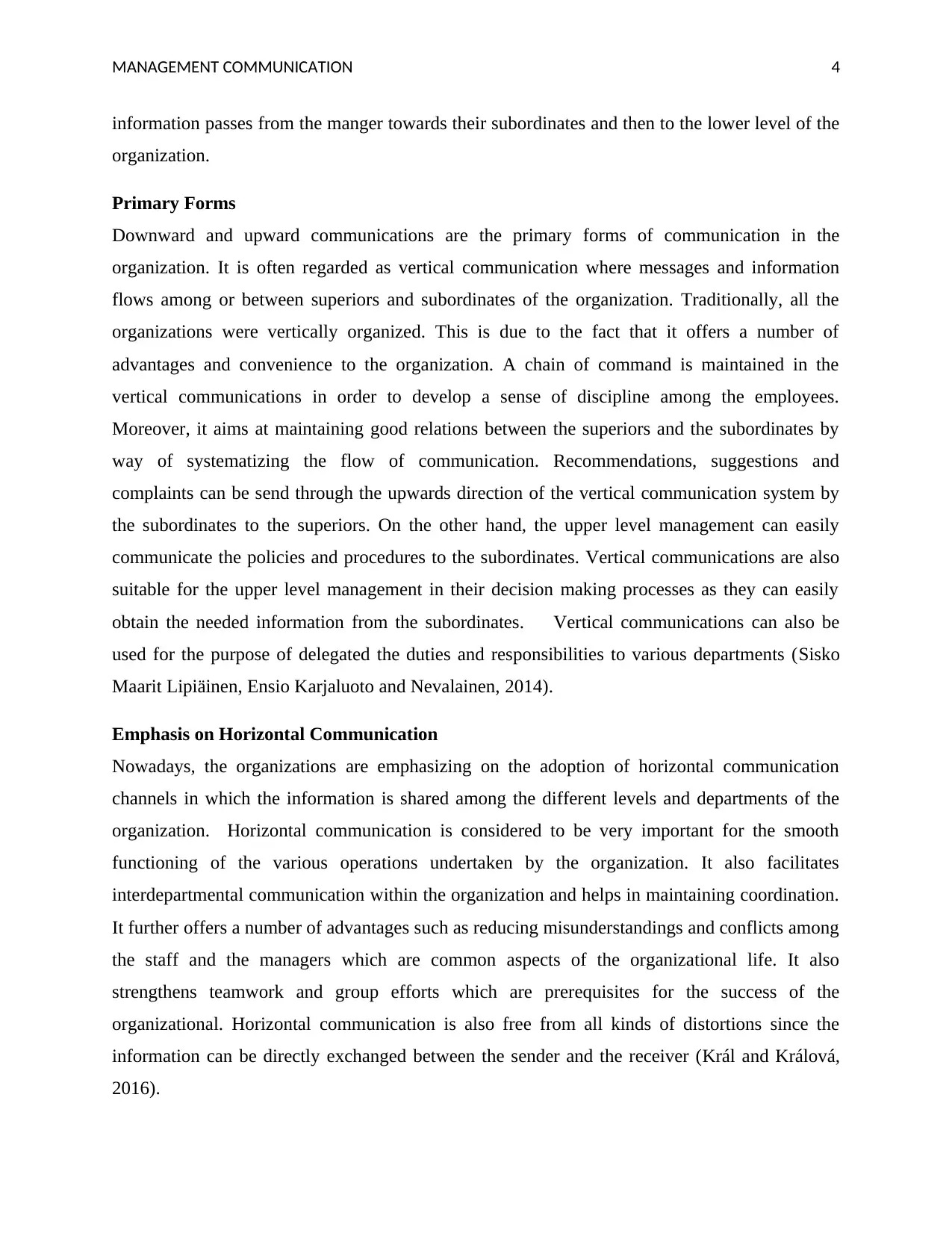
MANAGEMENT COMMUNICATION 4
information passes from the manger towards their subordinates and then to the lower level of the
organization.
Primary Forms
Downward and upward communications are the primary forms of communication in the
organization. It is often regarded as vertical communication where messages and information
flows among or between superiors and subordinates of the organization. Traditionally, all the
organizations were vertically organized. This is due to the fact that it offers a number of
advantages and convenience to the organization. A chain of command is maintained in the
vertical communications in order to develop a sense of discipline among the employees.
Moreover, it aims at maintaining good relations between the superiors and the subordinates by
way of systematizing the flow of communication. Recommendations, suggestions and
complaints can be send through the upwards direction of the vertical communication system by
the subordinates to the superiors. On the other hand, the upper level management can easily
communicate the policies and procedures to the subordinates. Vertical communications are also
suitable for the upper level management in their decision making processes as they can easily
obtain the needed information from the subordinates. Vertical communications can also be
used for the purpose of delegated the duties and responsibilities to various departments (Sisko
Maarit Lipiäinen, Ensio Karjaluoto and Nevalainen, 2014).
Emphasis on Horizontal Communication
Nowadays, the organizations are emphasizing on the adoption of horizontal communication
channels in which the information is shared among the different levels and departments of the
organization. Horizontal communication is considered to be very important for the smooth
functioning of the various operations undertaken by the organization. It also facilitates
interdepartmental communication within the organization and helps in maintaining coordination.
It further offers a number of advantages such as reducing misunderstandings and conflicts among
the staff and the managers which are common aspects of the organizational life. It also
strengthens teamwork and group efforts which are prerequisites for the success of the
organizational. Horizontal communication is also free from all kinds of distortions since the
information can be directly exchanged between the sender and the receiver (Král and Králová,
2016).
information passes from the manger towards their subordinates and then to the lower level of the
organization.
Primary Forms
Downward and upward communications are the primary forms of communication in the
organization. It is often regarded as vertical communication where messages and information
flows among or between superiors and subordinates of the organization. Traditionally, all the
organizations were vertically organized. This is due to the fact that it offers a number of
advantages and convenience to the organization. A chain of command is maintained in the
vertical communications in order to develop a sense of discipline among the employees.
Moreover, it aims at maintaining good relations between the superiors and the subordinates by
way of systematizing the flow of communication. Recommendations, suggestions and
complaints can be send through the upwards direction of the vertical communication system by
the subordinates to the superiors. On the other hand, the upper level management can easily
communicate the policies and procedures to the subordinates. Vertical communications are also
suitable for the upper level management in their decision making processes as they can easily
obtain the needed information from the subordinates. Vertical communications can also be
used for the purpose of delegated the duties and responsibilities to various departments (Sisko
Maarit Lipiäinen, Ensio Karjaluoto and Nevalainen, 2014).
Emphasis on Horizontal Communication
Nowadays, the organizations are emphasizing on the adoption of horizontal communication
channels in which the information is shared among the different levels and departments of the
organization. Horizontal communication is considered to be very important for the smooth
functioning of the various operations undertaken by the organization. It also facilitates
interdepartmental communication within the organization and helps in maintaining coordination.
It further offers a number of advantages such as reducing misunderstandings and conflicts among
the staff and the managers which are common aspects of the organizational life. It also
strengthens teamwork and group efforts which are prerequisites for the success of the
organizational. Horizontal communication is also free from all kinds of distortions since the
information can be directly exchanged between the sender and the receiver (Král and Králová,
2016).
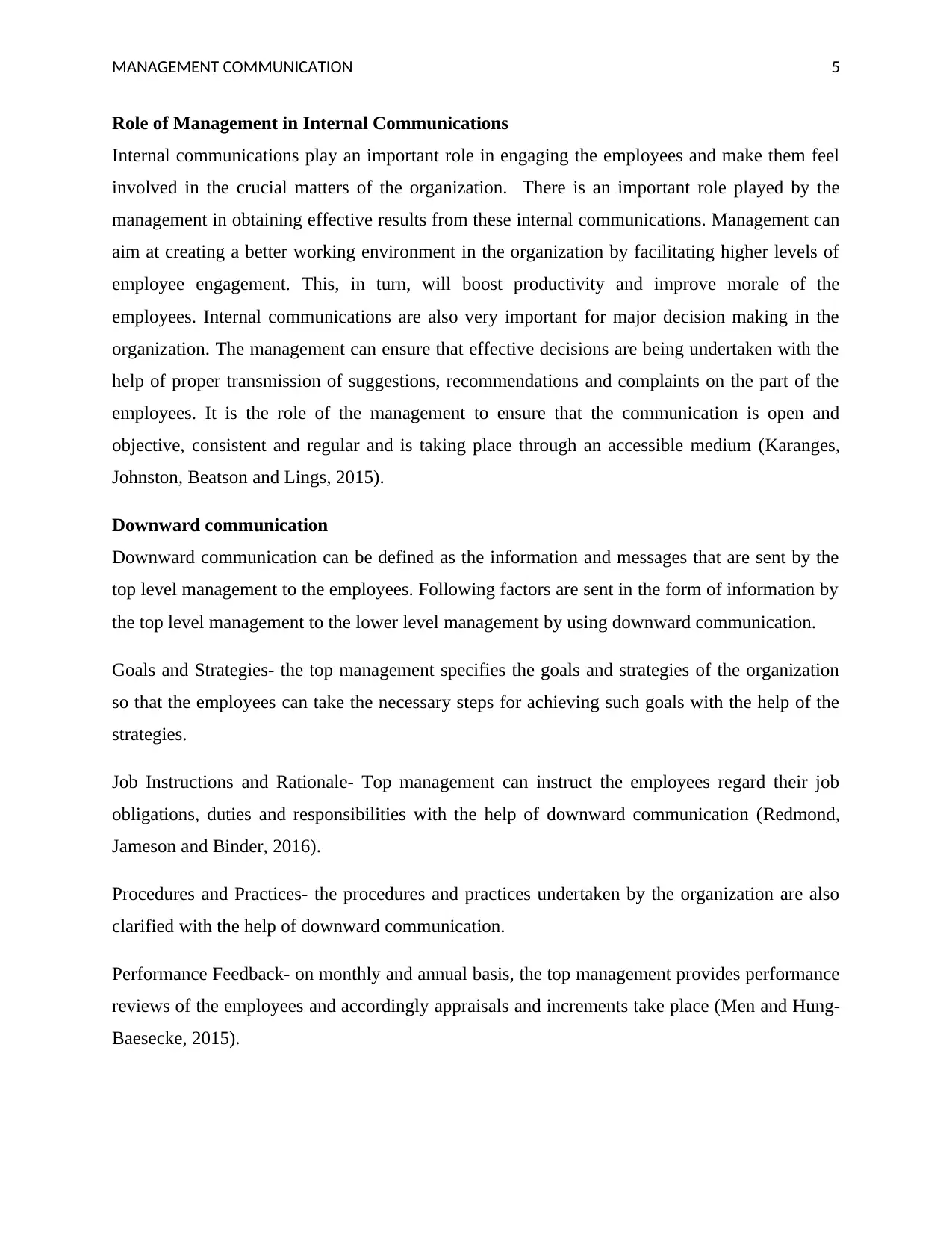
MANAGEMENT COMMUNICATION 5
Role of Management in Internal Communications
Internal communications play an important role in engaging the employees and make them feel
involved in the crucial matters of the organization. There is an important role played by the
management in obtaining effective results from these internal communications. Management can
aim at creating a better working environment in the organization by facilitating higher levels of
employee engagement. This, in turn, will boost productivity and improve morale of the
employees. Internal communications are also very important for major decision making in the
organization. The management can ensure that effective decisions are being undertaken with the
help of proper transmission of suggestions, recommendations and complaints on the part of the
employees. It is the role of the management to ensure that the communication is open and
objective, consistent and regular and is taking place through an accessible medium (Karanges,
Johnston, Beatson and Lings, 2015).
Downward communication
Downward communication can be defined as the information and messages that are sent by the
top level management to the employees. Following factors are sent in the form of information by
the top level management to the lower level management by using downward communication.
Goals and Strategies- the top management specifies the goals and strategies of the organization
so that the employees can take the necessary steps for achieving such goals with the help of the
strategies.
Job Instructions and Rationale- Top management can instruct the employees regard their job
obligations, duties and responsibilities with the help of downward communication (Redmond,
Jameson and Binder, 2016).
Procedures and Practices- the procedures and practices undertaken by the organization are also
clarified with the help of downward communication.
Performance Feedback- on monthly and annual basis, the top management provides performance
reviews of the employees and accordingly appraisals and increments take place (Men and Hung-
Baesecke, 2015).
Role of Management in Internal Communications
Internal communications play an important role in engaging the employees and make them feel
involved in the crucial matters of the organization. There is an important role played by the
management in obtaining effective results from these internal communications. Management can
aim at creating a better working environment in the organization by facilitating higher levels of
employee engagement. This, in turn, will boost productivity and improve morale of the
employees. Internal communications are also very important for major decision making in the
organization. The management can ensure that effective decisions are being undertaken with the
help of proper transmission of suggestions, recommendations and complaints on the part of the
employees. It is the role of the management to ensure that the communication is open and
objective, consistent and regular and is taking place through an accessible medium (Karanges,
Johnston, Beatson and Lings, 2015).
Downward communication
Downward communication can be defined as the information and messages that are sent by the
top level management to the employees. Following factors are sent in the form of information by
the top level management to the lower level management by using downward communication.
Goals and Strategies- the top management specifies the goals and strategies of the organization
so that the employees can take the necessary steps for achieving such goals with the help of the
strategies.
Job Instructions and Rationale- Top management can instruct the employees regard their job
obligations, duties and responsibilities with the help of downward communication (Redmond,
Jameson and Binder, 2016).
Procedures and Practices- the procedures and practices undertaken by the organization are also
clarified with the help of downward communication.
Performance Feedback- on monthly and annual basis, the top management provides performance
reviews of the employees and accordingly appraisals and increments take place (Men and Hung-
Baesecke, 2015).
⊘ This is a preview!⊘
Do you want full access?
Subscribe today to unlock all pages.

Trusted by 1+ million students worldwide
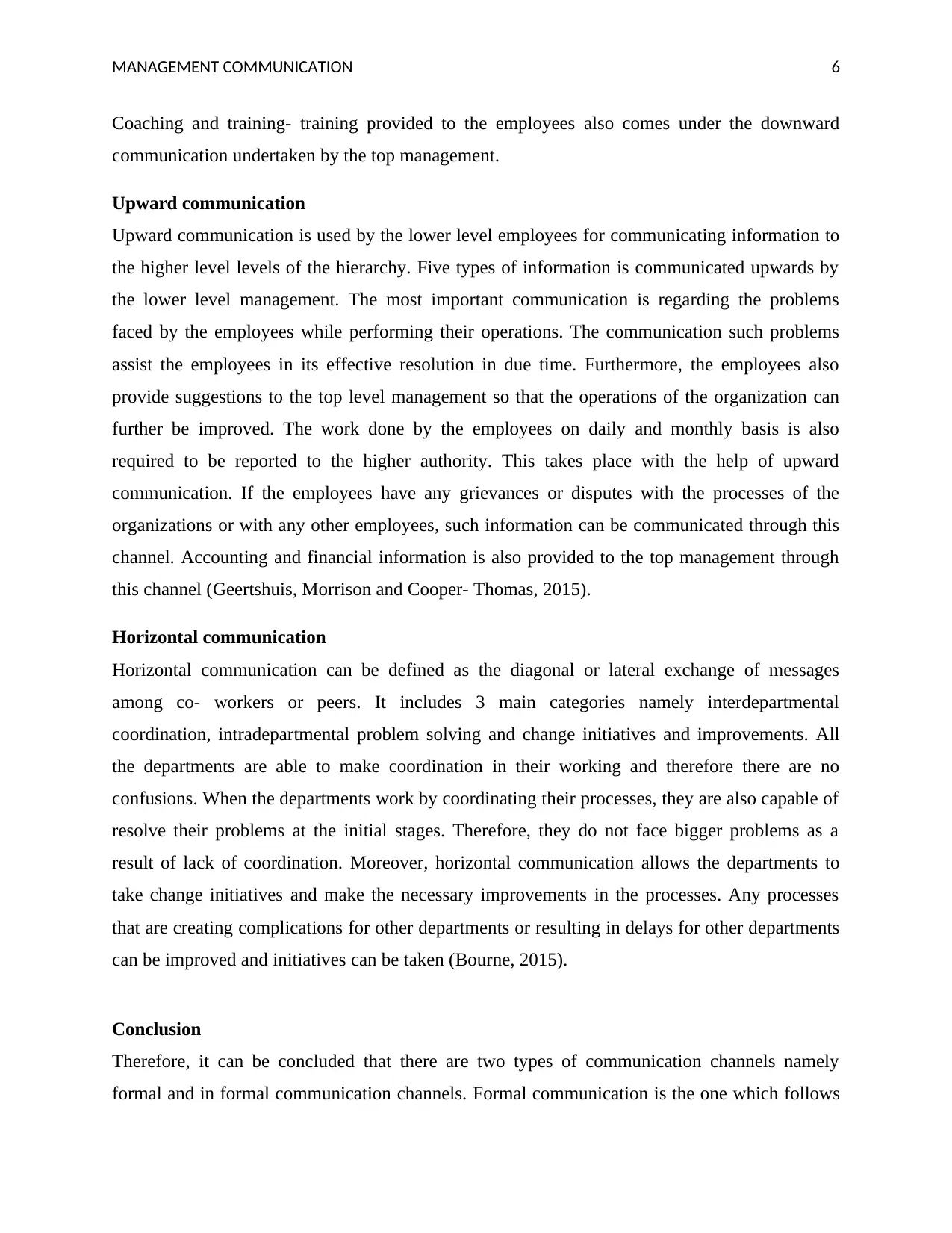
MANAGEMENT COMMUNICATION 6
Coaching and training- training provided to the employees also comes under the downward
communication undertaken by the top management.
Upward communication
Upward communication is used by the lower level employees for communicating information to
the higher level levels of the hierarchy. Five types of information is communicated upwards by
the lower level management. The most important communication is regarding the problems
faced by the employees while performing their operations. The communication such problems
assist the employees in its effective resolution in due time. Furthermore, the employees also
provide suggestions to the top level management so that the operations of the organization can
further be improved. The work done by the employees on daily and monthly basis is also
required to be reported to the higher authority. This takes place with the help of upward
communication. If the employees have any grievances or disputes with the processes of the
organizations or with any other employees, such information can be communicated through this
channel. Accounting and financial information is also provided to the top management through
this channel (Geertshuis, Morrison and Cooper- Thomas, 2015).
Horizontal communication
Horizontal communication can be defined as the diagonal or lateral exchange of messages
among co- workers or peers. It includes 3 main categories namely interdepartmental
coordination, intradepartmental problem solving and change initiatives and improvements. All
the departments are able to make coordination in their working and therefore there are no
confusions. When the departments work by coordinating their processes, they are also capable of
resolve their problems at the initial stages. Therefore, they do not face bigger problems as a
result of lack of coordination. Moreover, horizontal communication allows the departments to
take change initiatives and make the necessary improvements in the processes. Any processes
that are creating complications for other departments or resulting in delays for other departments
can be improved and initiatives can be taken (Bourne, 2015).
Conclusion
Therefore, it can be concluded that there are two types of communication channels namely
formal and in formal communication channels. Formal communication is the one which follows
Coaching and training- training provided to the employees also comes under the downward
communication undertaken by the top management.
Upward communication
Upward communication is used by the lower level employees for communicating information to
the higher level levels of the hierarchy. Five types of information is communicated upwards by
the lower level management. The most important communication is regarding the problems
faced by the employees while performing their operations. The communication such problems
assist the employees in its effective resolution in due time. Furthermore, the employees also
provide suggestions to the top level management so that the operations of the organization can
further be improved. The work done by the employees on daily and monthly basis is also
required to be reported to the higher authority. This takes place with the help of upward
communication. If the employees have any grievances or disputes with the processes of the
organizations or with any other employees, such information can be communicated through this
channel. Accounting and financial information is also provided to the top management through
this channel (Geertshuis, Morrison and Cooper- Thomas, 2015).
Horizontal communication
Horizontal communication can be defined as the diagonal or lateral exchange of messages
among co- workers or peers. It includes 3 main categories namely interdepartmental
coordination, intradepartmental problem solving and change initiatives and improvements. All
the departments are able to make coordination in their working and therefore there are no
confusions. When the departments work by coordinating their processes, they are also capable of
resolve their problems at the initial stages. Therefore, they do not face bigger problems as a
result of lack of coordination. Moreover, horizontal communication allows the departments to
take change initiatives and make the necessary improvements in the processes. Any processes
that are creating complications for other departments or resulting in delays for other departments
can be improved and initiatives can be taken (Bourne, 2015).
Conclusion
Therefore, it can be concluded that there are two types of communication channels namely
formal and in formal communication channels. Formal communication is the one which follows
Paraphrase This Document
Need a fresh take? Get an instant paraphrase of this document with our AI Paraphraser
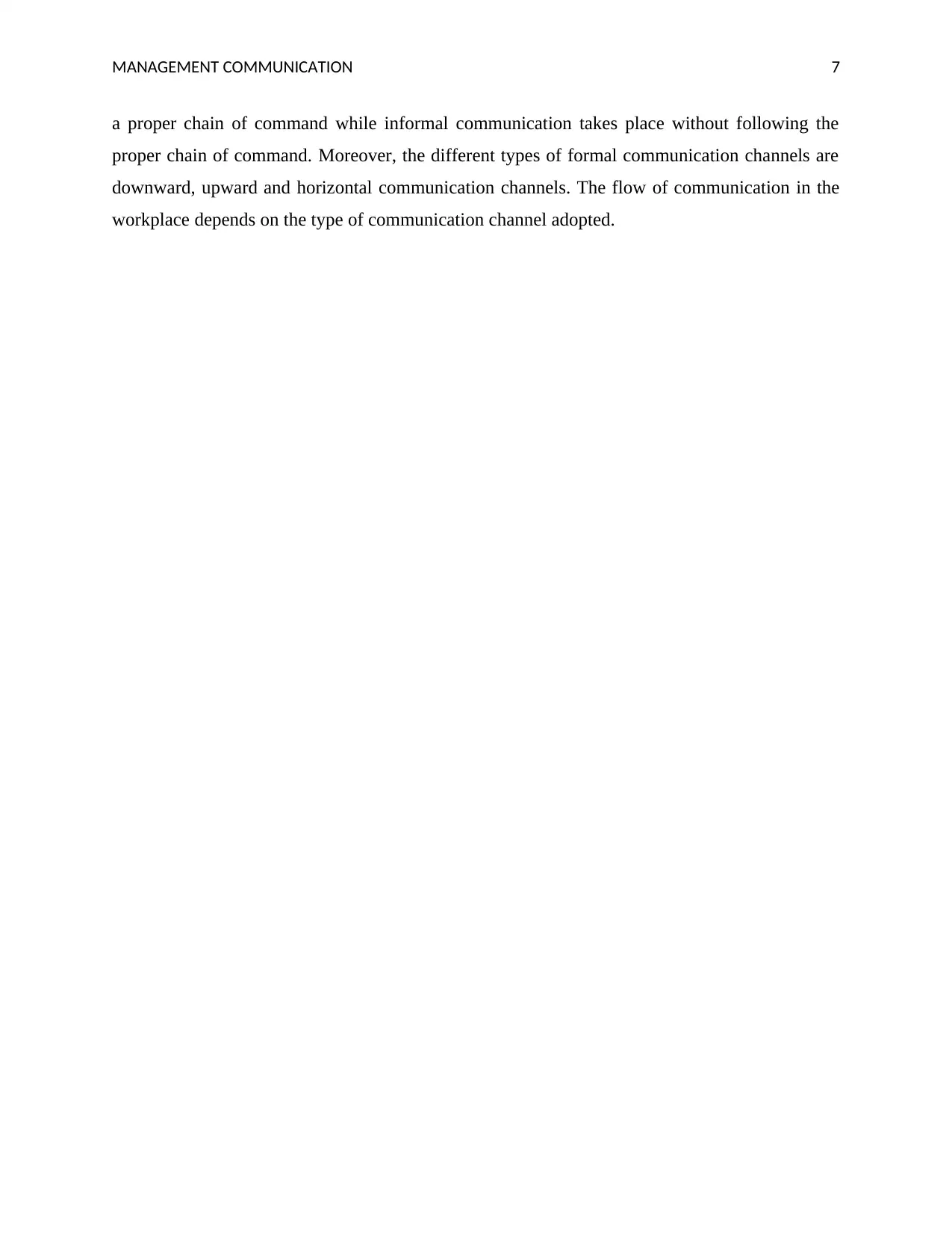
MANAGEMENT COMMUNICATION 7
a proper chain of command while informal communication takes place without following the
proper chain of command. Moreover, the different types of formal communication channels are
downward, upward and horizontal communication channels. The flow of communication in the
workplace depends on the type of communication channel adopted.
a proper chain of command while informal communication takes place without following the
proper chain of command. Moreover, the different types of formal communication channels are
downward, upward and horizontal communication channels. The flow of communication in the
workplace depends on the type of communication channel adopted.
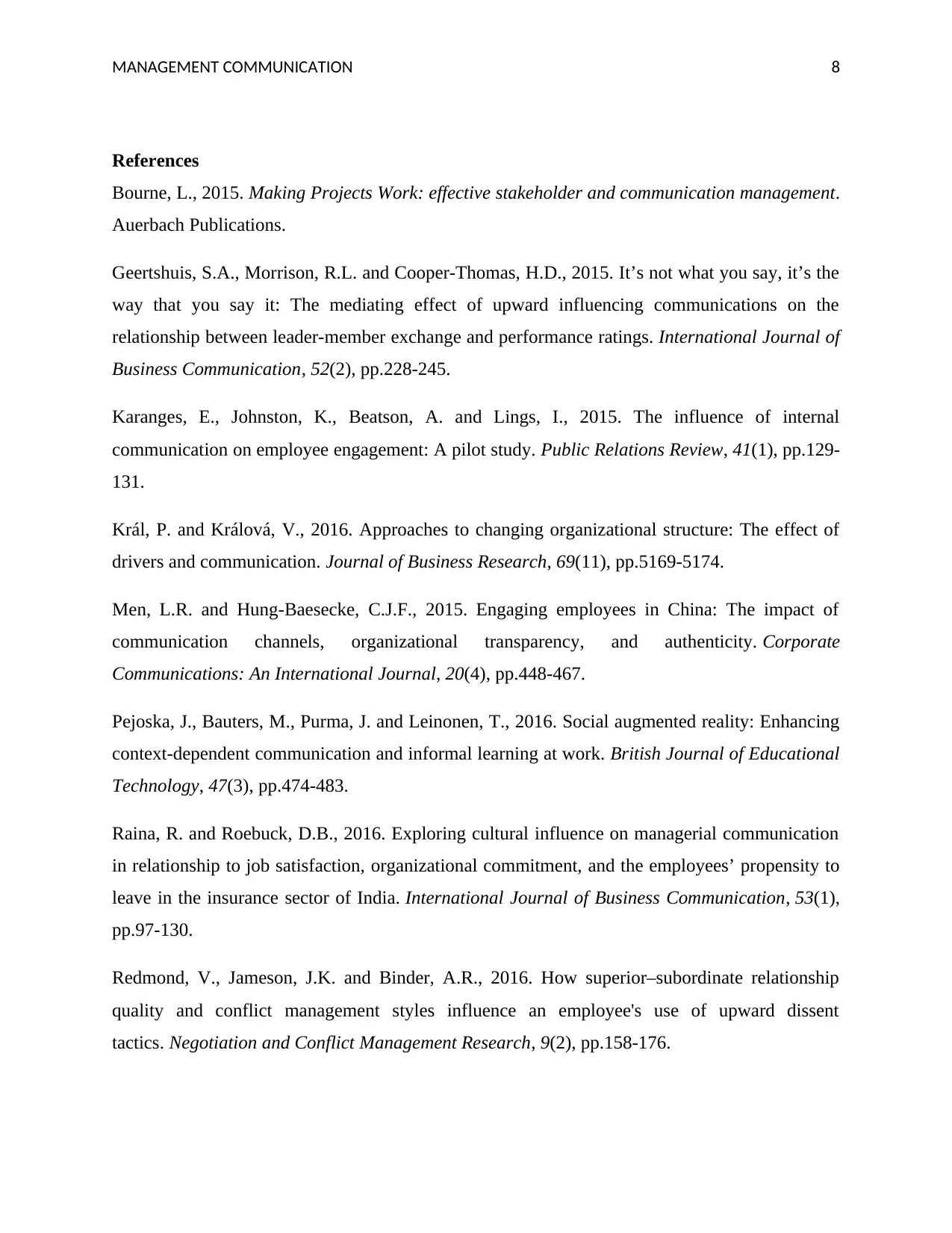
MANAGEMENT COMMUNICATION 8
References
Bourne, L., 2015. Making Projects Work: effective stakeholder and communication management.
Auerbach Publications.
Geertshuis, S.A., Morrison, R.L. and Cooper-Thomas, H.D., 2015. It’s not what you say, it’s the
way that you say it: The mediating effect of upward influencing communications on the
relationship between leader-member exchange and performance ratings. International Journal of
Business Communication, 52(2), pp.228-245.
Karanges, E., Johnston, K., Beatson, A. and Lings, I., 2015. The influence of internal
communication on employee engagement: A pilot study. Public Relations Review, 41(1), pp.129-
131.
Král, P. and Králová, V., 2016. Approaches to changing organizational structure: The effect of
drivers and communication. Journal of Business Research, 69(11), pp.5169-5174.
Men, L.R. and Hung-Baesecke, C.J.F., 2015. Engaging employees in China: The impact of
communication channels, organizational transparency, and authenticity. Corporate
Communications: An International Journal, 20(4), pp.448-467.
Pejoska, J., Bauters, M., Purma, J. and Leinonen, T., 2016. Social augmented reality: Enhancing
context‐dependent communication and informal learning at work. British Journal of Educational
Technology, 47(3), pp.474-483.
Raina, R. and Roebuck, D.B., 2016. Exploring cultural influence on managerial communication
in relationship to job satisfaction, organizational commitment, and the employees’ propensity to
leave in the insurance sector of India. International Journal of Business Communication, 53(1),
pp.97-130.
Redmond, V., Jameson, J.K. and Binder, A.R., 2016. How superior–subordinate relationship
quality and conflict management styles influence an employee's use of upward dissent
tactics. Negotiation and Conflict Management Research, 9(2), pp.158-176.
References
Bourne, L., 2015. Making Projects Work: effective stakeholder and communication management.
Auerbach Publications.
Geertshuis, S.A., Morrison, R.L. and Cooper-Thomas, H.D., 2015. It’s not what you say, it’s the
way that you say it: The mediating effect of upward influencing communications on the
relationship between leader-member exchange and performance ratings. International Journal of
Business Communication, 52(2), pp.228-245.
Karanges, E., Johnston, K., Beatson, A. and Lings, I., 2015. The influence of internal
communication on employee engagement: A pilot study. Public Relations Review, 41(1), pp.129-
131.
Král, P. and Králová, V., 2016. Approaches to changing organizational structure: The effect of
drivers and communication. Journal of Business Research, 69(11), pp.5169-5174.
Men, L.R. and Hung-Baesecke, C.J.F., 2015. Engaging employees in China: The impact of
communication channels, organizational transparency, and authenticity. Corporate
Communications: An International Journal, 20(4), pp.448-467.
Pejoska, J., Bauters, M., Purma, J. and Leinonen, T., 2016. Social augmented reality: Enhancing
context‐dependent communication and informal learning at work. British Journal of Educational
Technology, 47(3), pp.474-483.
Raina, R. and Roebuck, D.B., 2016. Exploring cultural influence on managerial communication
in relationship to job satisfaction, organizational commitment, and the employees’ propensity to
leave in the insurance sector of India. International Journal of Business Communication, 53(1),
pp.97-130.
Redmond, V., Jameson, J.K. and Binder, A.R., 2016. How superior–subordinate relationship
quality and conflict management styles influence an employee's use of upward dissent
tactics. Negotiation and Conflict Management Research, 9(2), pp.158-176.
⊘ This is a preview!⊘
Do you want full access?
Subscribe today to unlock all pages.

Trusted by 1+ million students worldwide
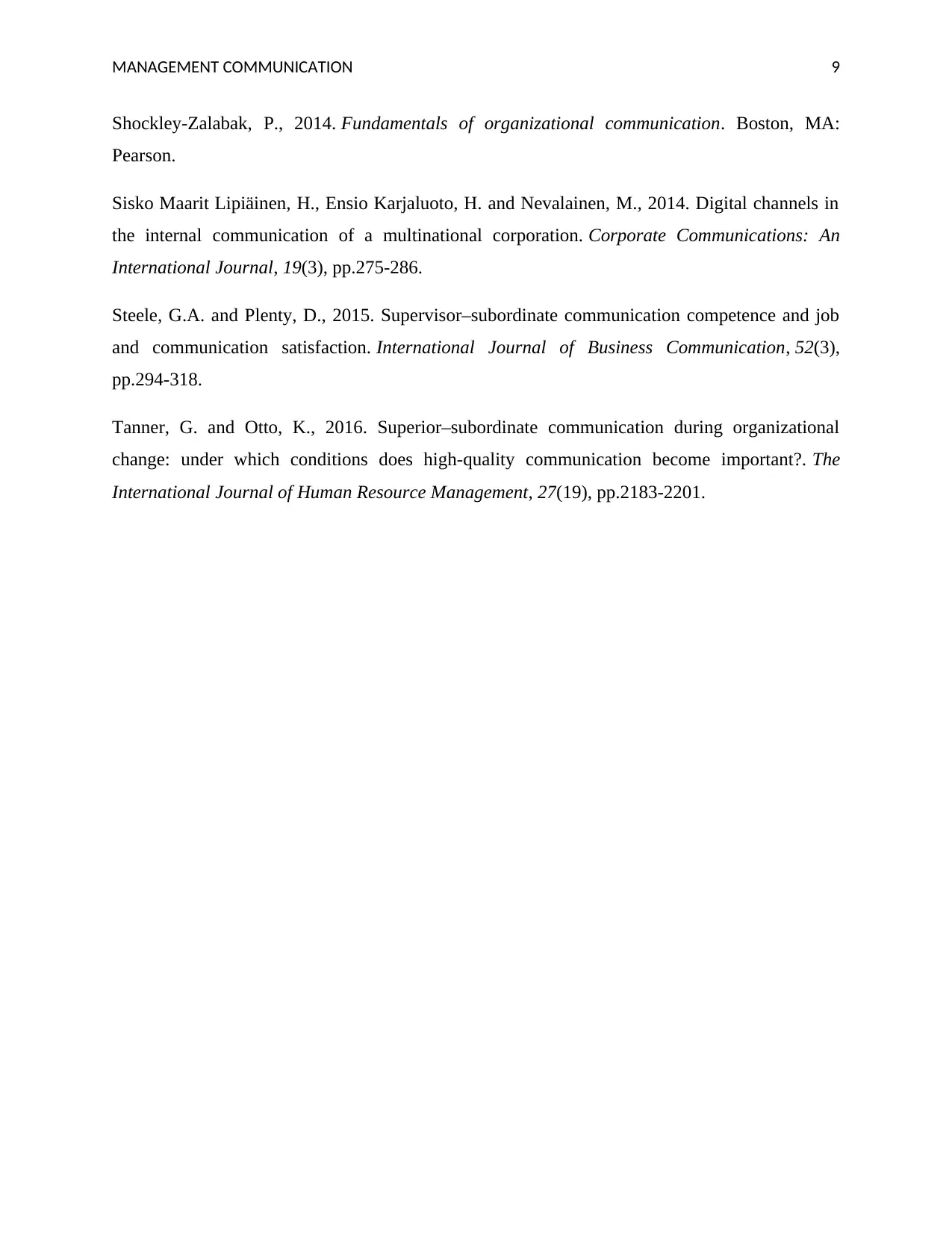
MANAGEMENT COMMUNICATION 9
Shockley-Zalabak, P., 2014. Fundamentals of organizational communication. Boston, MA:
Pearson.
Sisko Maarit Lipiäinen, H., Ensio Karjaluoto, H. and Nevalainen, M., 2014. Digital channels in
the internal communication of a multinational corporation. Corporate Communications: An
International Journal, 19(3), pp.275-286.
Steele, G.A. and Plenty, D., 2015. Supervisor–subordinate communication competence and job
and communication satisfaction. International Journal of Business Communication, 52(3),
pp.294-318.
Tanner, G. and Otto, K., 2016. Superior–subordinate communication during organizational
change: under which conditions does high-quality communication become important?. The
International Journal of Human Resource Management, 27(19), pp.2183-2201.
Shockley-Zalabak, P., 2014. Fundamentals of organizational communication. Boston, MA:
Pearson.
Sisko Maarit Lipiäinen, H., Ensio Karjaluoto, H. and Nevalainen, M., 2014. Digital channels in
the internal communication of a multinational corporation. Corporate Communications: An
International Journal, 19(3), pp.275-286.
Steele, G.A. and Plenty, D., 2015. Supervisor–subordinate communication competence and job
and communication satisfaction. International Journal of Business Communication, 52(3),
pp.294-318.
Tanner, G. and Otto, K., 2016. Superior–subordinate communication during organizational
change: under which conditions does high-quality communication become important?. The
International Journal of Human Resource Management, 27(19), pp.2183-2201.
1 out of 10
Related Documents
Your All-in-One AI-Powered Toolkit for Academic Success.
+13062052269
info@desklib.com
Available 24*7 on WhatsApp / Email
![[object Object]](/_next/static/media/star-bottom.7253800d.svg)
Unlock your academic potential
Copyright © 2020–2025 A2Z Services. All Rights Reserved. Developed and managed by ZUCOL.




